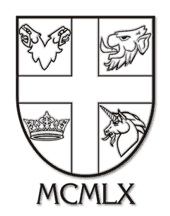
2004 Home | History | Patrons and Members | Premise | Provisional List of Orders | Italian Language
Authority and Status of the ICOC | Principles involved in assessing the validity of Orders of Chivalry | Index

Provisional List of Orders
which have been scrutinised by the Commission and pronounced to be found valid, according to the principles developed in the Edinburgh report. The appended list does not include the names of Orders of reigning Royal Houses (1963).
Note:
In all cases where there has been any uncertainty in connection with Dynastic Orders, we have applied for information to the Chanceries or Secretariats of the Sovereign Houses concerned, and we have, as a matter of course, endorsed their point of view as to the Orders belonging to or under the protection of such Houses. Although some of these Orders are not being granted at present and could therefore be listed as “dormant”, they are still jure sanguinis in the gift of their Sovereign Heads, who can at any time exercise their rights which have not been renounced.
(following open in new windows)
[19]
Not all the Commissioners agree about the listing. For the present purposes
it was decided to consider as dynastic all the various Orders still conferred
by formerly reigning dynasties, although it is evident that some of these decorations
were only State Orders or medals according to a scholarly point of view.
[20] These Orders were created as Dynastic Orders by princely houses, which
later became "mediatised" houses (and were not present at the Congress
of Vienna). They were erroneously included in the 1964 Register, contrary to
the 2nd principle.
[21] Decision of the General Assembly 2002 (see pp. 5-6).
[22] During the meeting of the Commission in Vienna (21.9.1970) it was decided
to amplify the study of chivalric subjects by inserting a list of Noble Corporations.
The basis of qualification is that such corporations should have a charter or
some form of statute from a Sovereign at some time in the past; their insignia
should be officially recognised in some form or other, and/or permitted to be
worn on uniform, either military or civil. (There are many organisations of
nobility which are of the highest social repute which do not comply with these
conditions, and no reflection is made upon them by not including them in this
list).
[23] Appreciating the fact that several nobiliary organisations of the highest
social standing and repute did not meet the qualifications for inclusion in
the "Nobiliary Corporations" section of this Register, the Commission
which met in Washington in 1984 established the new category of "Other
Nobiliary Bodies."
The basis for inclusion in this category is that such bodies must be entirely
noble in composition and possess real historical and cultural relevance within
their indigenous society. They may be armigerous and possess uniforms or insignia,
but such attributes do not in themselves constitute qualifications for recognition.
Synthetic nobiliary bodies, founded as a result of purely private initiatives
and lacking historical and cultural relevance do not qualify for inclusion in
this list.
[24] Appeared in the 1998 Register, they are decorations of ecclesiastical value
that have validity only inside the canonical Church which grants them.
The Commission has, since its inception, published updated Registers of Orders of Chivalry (in 1964, 1970, 1978, 1996, 1998), with the latest having been issued in 2001. However, it has been decided to re-examine all previous material, and accordingly all the decisions made with regard to the editions from 1964 to 1998 have been critically re-examined and removed.